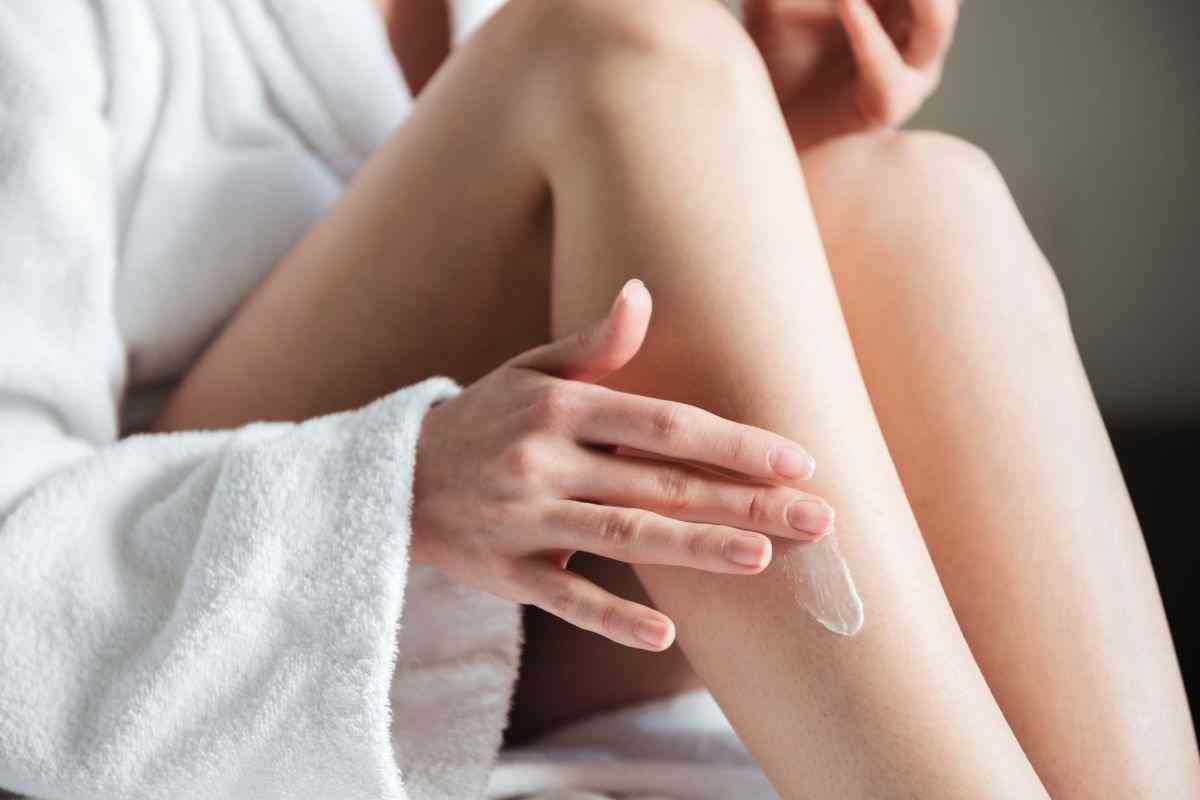Skin numbing creams such as Emla are licensed for topical anesthesia before needle insertions, for example, before an injection, commonly used before children’s immunizations, or to numb the area before superficial skin procedures. Numbing creams became a popular choice for off-license use as numbing tattoo creams.
This post will discuss over-the-counter availability of skin-numbing cream and a numbing gel from the pharmacy, their age restrictions, and pricing. Always read the patient information leaflet for detailed advice on administration methods, special warnings, and other important information about each numbing cream.
In this blog
ToggleSkin Numbing Cream: The Main Active Ingredients
Numbing creams from the pharmacy contain local anesthetic as the main active ingredient. Local anesthetics used in topical anesthetic creams include:
- Lidocaine
- Prilocaine (used together with Lidocaine)
- Tetracaine
Topical anesthetic creams temporarily block signals sent from the nerves in the skin, leading to the affected area’s numbing. Numbing creams are generally effective at relieving pain; regardless, they require an early application before any procedure occurs.
Numbing Cream Uses
Numbing creams are topical products designed to numb the skin and relieve pain or discomfort temporarily. They contain ingredients such as Lidocaine, prilocaine, or benzocaine, which block the nerve signals in the skin, thereby reducing the pain sensation.
Here are some common uses of numbing creams:
- Cosmetic Procedures: Numbing creams are frequently used to minimize pain or discomfort before various cosmetic procedures. These procedures include laser hair removal, tattooing, body piercing, micro-blading, waxing, and dermal fillers.
- Medical Procedures: Numbing creams are used in specific medical procedures to reduce pain or discomfort. Examples include injections, blood draws, minor skin surgeries, mole removal, and dermatological treatments.
- Tattooing and Body Art: Numbing creams are popularly used by tattoo artists to help alleviate pain during tattoo sessions, particularly for larger or more intricate designs.
- Waxing and Hair Removal: Numbing creams can be applied before waxing or removal procedures to reduce pain and discomfort caused by hair removal from the root.
- Minor Skin Irritations: Numbing creams can temporarily relieve pain or discomfort associated with minor skin irritations such as sunburn, insect bites, rashes, and minor burns.
It’s essential to follow the instructions provided with the numbing cream and consult with a healthcare professional or the product’s packaging for specific usage guidelines, potential side effects, and precautions.
OTC vs. Prescription Numbing Creams: Differences and Similarities
OTC (over-the-counter) and prescription numbing creams serve the common purpose of temporarily numbing the skin to relieve pain or discomfort. Nevertheless, there are differences between the two in terms of availability, ingredients, strength, and regulations.
OTC numbing creams can be purchased without a pharmacy or retail store prescription. They are regulated by government authorities to ensure their Safety for general use without medical supervision. These creams typically contain active ingredients such as Lidocaine, prilocaine, or benzocaine, although in lower concentrations than prescription numbing creams.
On the other hand, prescription-numbing creams require a prescription from a healthcare professional and can only be obtained from a pharmacy with a valid prescription. They may contain higher concentrations of active ingredients, making them potentially more potent and effective in numbing the skin. Prescription-numbing creams are subject to stricter regulations due to their higher potency.
OTC and prescription numbing creams can contain similar active ingredients like Lidocaine, prilocaine, or benzocaine. Nonetheless, prescription numbing creams may have higher concentrations of these ingredients.
OTC numbing creams are typically recommended for mild to moderate pain relief associated with minor skin irritations, superficial cosmetic procedures, or hair removal. With their higher potency, prescription numbing creams may be prescribed for more complex medical or dermatological procedures requiring more significant anesthesia.
Whether you’re using an OTC or prescription numbing cream, it is crucial to carefully follow the instructions, adhere to recommended dosages, and be aware of potential side effects or allergic reactions. Consulting with a healthcare professional is always advised to ensure the safe and effective use of any numbing cream.
Skin Numbing Creams: Top 7 Picks
| Skin Numbing Creams | Uses | Side Effects | Availability |
|---|---|---|---|
| Emla Cream | Numbing skin | Dizziness, Fainting | OTC |
| LMX4 Cream | Reduce skin irritation | Redness, Seizures | OTC |
| Ametop Gel | While injecting a needle | Swelling, Itching | OTC |
| Denela Cream | Temporary numb the skin | Skin irritation, Dry skin | OTC |
| Lidocaine 5% Ointment | Discomfort on the skin | Scaly skin, Irritation | OTC |
| Lanacane Cream | Treat skin conditions | Burning, redness | OTC |
| Evo-10 | While making a tattoo or skin issues | Itching, Tingling | OTC |
1. Emla 5% Skin Numbing Cream (2.5% lidocaine, 2.5% prilocaine)
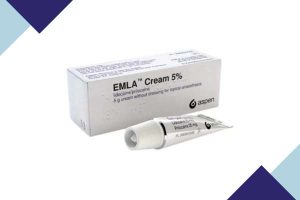
Emla cream is the most popular numbing cream requested by the public and prescribed by GPs. Emla skin numbing cream is licensed for newborn infants 0-2 months and all other age groups of children and adults. EMLA cream should not be used at less than 37 weeks gestational age (eMC, 2019).
Emla cream is available as an individual 5g tube or an Emla OTC cream pack containing a 5 g tube and two occlusive dressings.
Two dressings included in the OTC pack are 3M Tegaderm dressings (6 cm x 7 cm). Some pharmacies may be able to supply Tegaderm condiments separately when non-OTC Emla cream is purchased. You can also read emla cream for premature ejaculation.
How And When To Apply Emla Cream?
Individual Emla numbing cream is slightly cheaper than the OTC pack. The prices vary between pharmacies, but you should pay around £4 for personal numbing cream and about £5 for the Emla OTC pack.
- It is recommended to apply Emla cream at least 60 minutes before needle insertion. Check product information leaflets for applications before other procedures.
- ½ of the tube is applied to the area. Emla should not be rubbed in.
- Adhesive Tegaderm dressing should be applied to the area.
- The dressing should be left in place for at least 60 minutes.
- After 60 minutes, the dressing should be removed, and the area should be cleaned with alcohol before the procedure.
2. LMX4 Skin Numbing Cream (4% lidocaine cream)

In clinical tests, LMX4 gave consistent analgesia when administered for 30 to 60 minutes. If enough analgesia is not attained, the cream may remain on the skin after this period. LMX4 contains Lidocaine as the main active ingredient. LMX4 numbing cream is licensed for children over 1 month of age.
- LMX4 cream should be applied at least 30 minutes before the skin procedure.
- LMX4 costs around £5 per 5g tube without dressing.
3. Ametop Gel (4% Tetracaine)
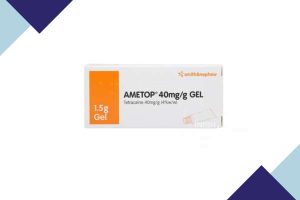
Ametop is available in the gel formulation and comes in a 1.5g tube. It is licensed for infants over one month, children, and adults. Ametop numbing gel is not recommended for infants under one month of age. Ametop gel should be applied 30-45 min before the skin procedure. More extended applications are not necessary.
Keep Ametop gel in the fridge. It may be stored for up to 1 month at 25°C before use. Ametop gel is cheaper than the above-numbing creams, costing around £2 per tube (remember Ametop’s smaller pack size).
4. Denela 5% Cream
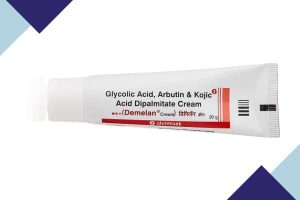
Denela, 5% cream, contains the same active ingredients as Emla cream, 2.5% lidocaine, and 2.5% prilocaine. Two versions of Denela % skin numbing cream exist:
- Denela 5% in 5g tube
- Denela 5% in 5g tube with two dressings
The price of Denela, 5% cream, is very close to Emla cream. You can purchase Denela 5% cream online. You would need a pharmacy staff to order one from the leading wholesalers as Denela is not commonly prescribed in the UK compared to other anesthetic creams such as Emla. Denela Cream is licensed for babies from 38 weeks old and adults.
The directions for applying the cream vary between indicated uses; therefore, please refer to the product information leaflet for more details.
5. Lidocaine 5% Ointment
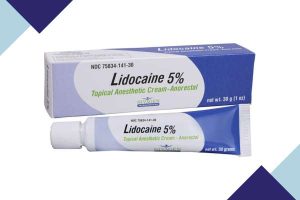
Although not a cream, I want to include Lidocaine 5% ointment as it can be used as a numbing skin product.
Lidocaine, a 5% ointment, is a pharmacy-only medicine in the dispensary. Therefore, a request must be made to purchase Lidocaine over the counter.
Lidocaine, 5% ointment, is licensed as the numbing product to:
- Help to numb the skin
- To numb the gums in dentistry
- To relieve the pain caused by different conditions, including anal fissures (a small tear)
- To relieve sore nipples in mothers who breastfeed
There are no specific age restrictions for using Lidocaine 5% ointment. Lidocaine ointment can be used by older people, adults, and children.
6. Lanacane Skin Numbing Cream (benzocaine 3% cream)

Lanacance cream contains benzocaine as an active ingredient. Although benzocaine is classified as a local anesthetic, the licensed use of Lanacane cream differs from previously discussed numbing creams. Lanacane is authorized to:
- Relieve pain, itching, irritation due to insect bites, and skin irritation. Read more about ointments or creams for insect bites.
- Relief itchiness of the external genital and anal area.
Lanacane is a General Sales Licence (GSL) product. It can be purchased in any shop or, most likely, in a supermarket or a pharmacy. You can buy Lanacane online. Lanacane is licensed for adults and children from 12 years of age.
7. Evo-10 Skin-Numbing Cream (lidocaine 10% cream)
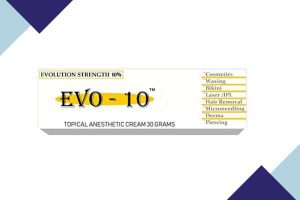
Evolution 10 (Evo-10) is the only numbing cream that can be purchased ‘over the counter,’ mainly online. Evo-10 contains Lidocaine 10%, a local anesthetic.
Evo-10 can be used to numb the skin before:
- Waxing
- Hair removal
- Microneedling
- Piercing
- Needle Procedures (tattooing)
Where Can You Buy A Skin-numbing Cream?
Numbing creams are licensed as pharmacy-only medicines (P). P medicines are sold only in the pharmacy. Numbing creams are kept in the dispensary and not displayed to the public. This means that one needs to ask a staff member to purchase one. When requested, a pharmacist will most likely ask about the intended use of the cream. Topical anesthetic creams can also be bought online from registered pharmacies.
Skin Numbing Cream: Common Side Effects
Common side effects associated with the use of local anesthetic creams (excluding Lanacane) include:
- skin irritation
- redness at the application site
- swelling at the application site
The experience of side effects differs and depends on the treatment area.
Can You Use A Skin-numbing Cream Before Children’s Immunisations?
Use topical numbing creams before children’s vaccinations. Numbing cream will decrease the pain of needle insertion but will not take the pain completely away.
Can You Buy Skin-numbing Cream For A Tattoo Procedure Or Piercing?
Licensed use of all the above numbing products is associated with medical procedures. Customers requesting numbing creams for applications before the tattoo or piercing procedures will most likely be refused.
Final Words From AzDrug
Skin numbing cream will be necessary to experience a “No feel effect” on your skin if you want to make your skin insensitive. This is mainly used when you need a tattoo while taking an injection or for any other purpose. The 7 best numbing creams are mentioned above for your usage and to eliminate skin pain. You may go through common side effects: redness and skin irritation. The use of the medicine might differ depending on the quantity, but it will give you the best results. You should be aware of the time for applying the skin-numbing cream. There is no need to have a prescription to purchase skin-numbing cream.
Can I buy EMLA cream over the counter?
Yes. You can buy EMLA cream over the counter. EMLA cream is a pharmacy-only medication that can only be purchased from a registered pharmacy (conventional or online).
How much does EMLA cream cost?
EMLA cream costs around £4.50 for a 5g tube. OTC EMLA packs (come with two dressings) cost around £5. Prices may vary between pharmacies.
Can EMLA be used on broken skin?
The product information states that EMLA Cream is applied to intact skin under an occlusive dressing.
How long do you leave lidocaine cream on?
EMLA cream should be applied 60 minutes before needle insertion. LMX4 cream (4% lidocaine) should be used at least 30 minutes before the skin procedure. Read the product information leaflet for more details.

